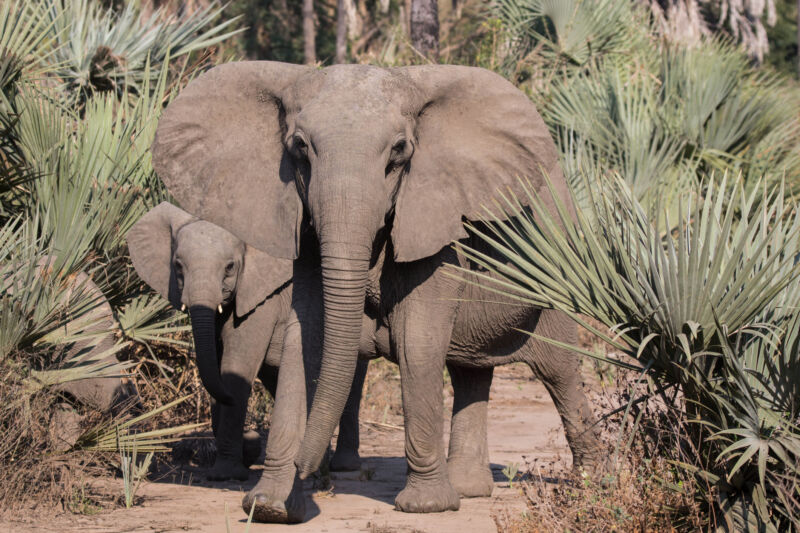Evolve or get shot —
Researchers have identified genetic factors that stop tusk development.
John Timmer
–

Enlarge / A tuskless elephant in Mozambique.
Because of poaching problems, some wildlife authorities have resorted to removing the horns of rhinos to eliminate the reason they’re poached in the first place. As it turns out, evolution came up with a similar solution.
A 15-year-long civil war in Mozambique set off a burst of poaching that ultimately killed 90 percent of a national park’s elephant population. Afterward, tuskless elephants were seen in the park. That’s surprising, since tusks play an important role in elephants’ foraging and defense against predators. Now, researchers have revealed that the absence of tusks was the result of genetic changes and have even identified the genes that were likely behind it.
A change of face
Over the course of the Mozambican Civil War, the population of elephants in Gorongosa National Park dropped from 2,542 to just 242. But the remaining population contained a significant number of elephants that lacked tusks. Models of the population suggest that the animals without tusks were roughly five times more likely to survive than their fellows with tusks.
Strikingly, tusklessness was seen exclusively in females. That’s an unusual pattern. Males have only one copy of the X chromosome, while females have two. Thus, any recessive mutation—one that doesn’t have an effect if a normal copy of the gene is present—is more likely to be seen in males, since they would only have one copy and thus can’t have a normal copy. A dominant mutation, where effects are seen even if a normal copy of the gene is around, would explain the appearance of the phenomenon in females. But then we’d also expect to see it in males.
The solution to this confusion is a complex pattern of inheritance, a mutation that causes a visible change in a dominant manner and also causes lethality in a recessive way. So dominant tusklessness explains why we see females without tusks. But the recessive lethality means that any males that might develop without tusks end up dying instead. (Because there are no males with the mutation, it’s impossible for a female to end up with two copies of a mutant X chromosome, since one X chromosome always comes from their fathers.)
If you consult Mendel, it’s possible to predict what you’d see in offspring if you were looking at this sort of inheritance. For a mother without tusks, half of her male offspring would inherit the mutation and die. That means males should be born at half the rate of females. Among the female offspring, half should inherit the mutation and lack tusks. The new research confirms that this is exactly the pattern of inheritance seen among the elephants of Gorongosa National Park.
Using evolution to find a gene
The confirmation that this pattern behaved like a genetic change suggested that the tuskless elephants were an evolutionary response to poaching. So the researchers obtained genome sequences from tusked and tuskless elephants and scanned the X chromosome for regions that showed high levels of differences between the two types of elephants. This led the researchers to a region that contains a gene called amelogenin, which is involved with forming the enamel on teeth in other mammalian species.
In humans, the deletion of this area of the genome also causes problems with tooth formation and lethality in males. The lethality is actually linked to the gene next to the one needed for tooth formation. So the two different effects—tusk formation and lethality—actually could be separated but are frequently both affected by a single deletion.
Oddly, a second part of the X chromosome came through this analysis, but it only contains the remains of a gene that was inactivated by mutations in the distant past. The reason for that finding is unclear.
Finally, the researchers also scanned the rest of the genome for similar regions and discovered one that includes a gene involved in the formation of dentin, part of the structure of teeth. Given the pattern of inheritance linked to the X chromosome, it’s not clear how significant this gene is to the absence of tusks. It’s possible that it enables or enhances the effect of the mutation on the X, but we don’t know for sure.
The population will be worth following as it bounces back from its brush with extinction. As noted above, elephants use their tusks for foraging and defense, so there may be a complete reversal of the evolutionary selection that eliminated the tusks in the first place, with circumstances now favoring the tusked animals. Having fewer tusked elephants (and fewer elephants in general) may set off significant ecological changes in the park, since the animals’ ability to use their tusks to damage trees is thought to be partly responsible for the grassy savannah they inhabit.
Science, 2021. DOI: 10.1126/science.abe7389 (About DOIs).

